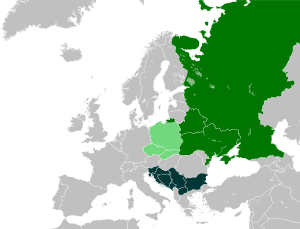Bunjevci
Bunjevci (Serbo-Croatian pronunciation: [bǔɲeːʋtsi, bǔː-]) are a South Slavic ethnic group living mostly in the Bačka region of Serbia (province of Vojvodina) and southern Hungary (Bács-Kiskun county, particularly in the Baja region). They presumably originate from western Herzegovina, whence they migrated to Dalmatia, and from there to Lika and Bačka in the 17th century.[1] Bunjevci who remained in Bosnia and Herzegovina, as well as those in modern Croatia today maintain that designation chiefly as a regional identity, and declare as ethnic Croats. Those who emigrated to Hungary were largely assimilated, and assumed Hungarian or Croatian designation. Bunjevci are mainly Roman Catholic, and speak the Bunjevac dialect of Croatian with Ikavian pronunciation and with certain archaic characteristics. During the 18th and 19th century, they formed a sizable part of the population of northern Bačka, but many of them were gradually assimilated into larger ethnic groups in the region.
| Total population | |
|---|---|
| Unknown; those in Serbia declaring themselves either as Bunjevci or Croats | |
| Regions with significant populations | |
| Serbia | 16,706 (2011 census) |
| Hungary | c. 1,500 (2001 census) |
| Languages | |
| Croatian (Bunjevac dialect) | |
| Religion | |
| Roman Catholicism | |
| Related ethnic groups | |
| Šokci, Croats and other South Slavs | |
Ethnology
The Bunjevci are a South Slavic ethnic group, Catholic by religion, and Western Shtokavian-Ikavian by dialect,[2] of which majority who still declares as Bunjevci live in the Bačka region in Serbia and Bács-Kiskun county in Hungary.
Ethnonym
Their endonym, used in Serbo-Croatian, is Bunjevci (Serbo-Croatian pronunciation: [bǔɲeʋtsi]).[3] In Hungarian their name is bunyevácok, while in German Bunjewatzen. According to Petar Skok they also called themselves in Bačka as oò*kac (Šokac), while Hungarians in Szeged also called them as Dalmát (Dalmatians; Dalmatini),[4] which they also used for themselves in Hungary.[5] In addition, the term meant Catholic (Croat) population from Livanjsko field up to Montenegro which was mostly considered by the neighbor Serbian Orthodox population,[6] while at Peroj in Istria it was a pejorative name for Croats as well pobunjevčit pejorativelly meant "become Catholic".[4] In the 20th century hinterland of Novi Vinodolski, called as Krmpote, the Primorje (Littoral or Coastal) Bunjevci were economically less powerful rural population and hence it had an attribution of "otherness" with negative connotation by urban citizens. Compared to Sveti Juraj they were more powerful and refused to call themselves Bunjevci because of such broad connotation and rather used "Planinari" (Mountaineers), and the citizens name "Seljari" had negative and mockery connotation by Bunjevci.[7] In the territory from Krmpote to Sv. Marija Magdalena in North Dalmatia there also existed multilayered regional identities Primorci and Podgorci, local Krmpoćani, while the subethnic term Bunjevci loses identity on the boundary with Velebit Podgorje.[8]
The earliest mention of the ethnonym is argued to be in 1550 and 1561 when in a charter is recorded certain Martin Bunavacz in Baranja.[9] The earliest mention in Bačka is from 1622 when was recorded parochia detta Bunieuzi nell' arcivescovato Colociense.[10] One of the first mentions of the ethnonym is by Bishop of Senj, Martin Brajković, in 1702 whose recorded folk tradition knew for the existence of five ethnic identities which constitute the population of Lika and Krbava, one of them being Catholic Vlachs also known as Bunjevci (Valachi Bunyevacz).[11] In 1712/1714 census of Lika and Krbava was recorded only one Bunieuacz (Vid Modrich), however the military government usually used alternative term Valachi Catolici, while Luigi Ferdinando Marsili called them Meerkroaten (Littoral Croats).[12][2] Alberto Fortis in Viaggio in Dalmazia (1778, English edition) describing the Velebit (Montagne della Morlacca) recorded that the population was different from the earlier and called themselves as Bunjevci because they came from area of Buna in Bosnia and Herzegovina.[13] 1828 writing by Colonel Ivan Murgić probably had the last original testimony of Lika-Primorje Bunjevci about their traditional identity, in which they said to be "We are hardworking brothers Bunjevci", while regarding (Catholic) confession always as "I am true Bunjevac".[14] A more recent 1980 testimony from Baja, Hungary considered they came from Albania.[15]
The etymological derivation of their ethnonym is unknown.[15] There are several theories about the origin of their name. The most common is that the name derives from the river Buna in central Herzegovina,[4] their hypothesized ancestral homeland before their migrations. However, although preserved in Littoral and mostly in Podunavlje branch folk oral tradition, linguists generally dismissed such derivation.[15] Another theory is that the name comes from the term Bunja, a traditional stone house in Dalmatia similar to Kažun in Istria, meaning people who live in such type of houses,[9][16] from personal name Bunj deriving from Bunislav or Bonifacije, Romanian personal name Bun from Bonus from which derives toponym Bunić near Gospić,[4] [17] and pejorative nickname Obonjavci which is recorded since 1199 in Zadar probably meaning soldiers without order and discipline.[18]
Origin theories
The most common view is that the community fled western Herzegovina and Dalmatia to Vojvodina during the 17th-century Ottoman invasion, led by Franciscan friars, and was accepted in the Military Frontier.[19] The Catholic Church in Subotica celebrates 1686 as the anniversary of the Bunjevci migration, when the largest single migration did take place.[19] According to modern historiographical studies based on archival research, there is still no consensus on their homeland, only ethnological elements indicate specific regions. It is considered to be Southwestern Bosnia, Herzegovina, and Dalmatia, from where in the 17th century migrated to Bačka and Northern Dalmatia, as well as Lika, Primorje and Gorski Kotar. This with a political situation divided the community into four groups, Western Herzegovinian (Ottoman), Dalmatian (Venetian), Lika-Primorje (Habsburg), and Podunavlje (Hungarian), although the ethnologists often consider the first two as one group (broad Dalmatian) from which other diverged.[1][20] However, it is considered that some groups already existed since 1520 on the Triplex Confinium (the boundary between Venetian, Ottoman, and Habsburg Empire), but were not directly mentioned in historical documents, rather than were used alternative terms due to social-regional-ethnic-linguistic-cultural reasons such as Uskoks, Morlachs, Morlachi catolichi, Valachi catolichi and catholische Walahen, Rasciani catolichi and Katolische Ratzen (the term had transconfessional meaning[2]), Iliri, Horvati, Meerkroaten, Likaner.[13][8] In the territory of Croatian Military Frontier happened complex ethnic-demographic integrations, with Ledenice being one of the earliest examples of Croatian-Vlachian-Bunjevac integration when an anonymous priest from Senj in 1696 calls them as nostris Croatis, while captain Coronini in 1697 as Croati venturini, at the same time (1693), chiefs of Zdunići in Ledenice emphasized their Bunjevci (Krmpote) ancestry.[2]
According to modern and most recent ethnological studies, as well anthroponymy structure,[8] Bunjevci have substantial elements of non-Slavic origin (Vlachian, Albanian) and originate from Vlachian-Croatian ethnic symbiosis of Ikavian Chakavian/Chakavian-Shtokavian language group, with some similarities to Vlachian-Montenegrin symbiosis, but both being more archaic and different to the Vlachian-Serbian symbiosis of Ekavian/Jekavian-Shtokavian group.[21] Based on ethnological, linguistic and some historical indicators the area of origin could have been between rivers Buna in Herzegovina and Bunë in Albania, along with the Adriatic-Dinaric belt (south Dalmatia and its hinterland, Boka Kotorska Bay, the coast of Montenegro and a part of its hinterland),[22] seemingly encompassing the territory of the so-called Red Croatia, regardless of the issue whether the entity is historically founded, which was partly inhabited by Croats according to Byzantine sources from 11th and 12th century.[22][23] This is supported by the observed Alpine cattle-breeding among Bunjevci at Velebit Podgorje, which is a non-Dinaric type of cattle-breeding in the Dinaric mountains.[24] In a study about Western Balkans household and families, Austrian historian of historical anthropology Karl Kaser argued a probable Vlach origin of Bunjevci who became absorbed in Catholic Croat community.[25]
National status dispute
Disputes over the national status of the Bunjevci go back to the nationalism wave in the 19th century in Austria-Hungary, but their "national status" remained ambiguous since, as the debate revived by the Breakup of Yugoslavia in the 1990s.[26] It has been argued that they are Croats, Serbs, and yet another as a fourth nation of the Kingdom of Serbs, Croats and Slovenes among the South Slavic nations.[26] In the period between 1920 and 1930 and again in 1940, there were three types of manipulation to neutralize their Croatian nationality, primarily emphasizing their ethnic distinctiveness from both the Croats and Serbs, that can be both Croats and Serbs or it's unimportant because both are Yugoslavs, and open denial of their ethnicity and religious belonging considering that Bunjevci and Šokci are Serbs of the Catholic faith.[27] The third was argued by Serbian academic elite, including Aleksa Ivić, Radivoj Simonović, Jovan Erdeljanović among others. Some Croatian authors reject these point of view as unfounded one.[27]
History
Early Modern Period and Austro-Hungarian Empire
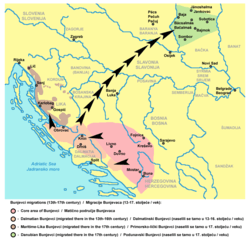
The migrations from Northern Dalmatia were influenced by Ottomans conquest in the 15th and 16th century, and the first migration to Primorje is considered to have happened in 1605 when around 50 families from Krmpota near Zemunik settled in Lič near Fužine by Danilo Frankol, captain of Senj, in agreement with Nikola and Juraj Zrinski,[16][28] and with several waves until 1647 settling in Lič, the hinterland of Senj (Ledenice, Krmpote - Sv. Jakov, Krivi Put, Senjska draga), and some to Pag and Istria. Some also arrived during the Cretan War (1645–1669), and after the Ottomans defeat in Lika (1683–1687), some littoral Bunjevci moved to settlements in Lika, like Pazarište, Smiljan, Gospićko field, Široka Kula, valley of Ričice and Hotuče.[8] According to the common theory based on historical documents happened at least three big migrations to Podunavlje, first from the beginning of the 17th century (without Franciscan friars[29]), second in the mid 17th century during Cretan War, and third during Great Turkish War (1683–1699).[29]
In 1788 the first Austrian population census was conducted – it called Bunjevci Illyrians and their language the Illyrian language. It listed 17,043 Illyrians in Subotica. In 1850 the Austrian census listed them under Dalmatians and counted 13,894 Dalmatians in the city. Despite this, they traditionally called themselves Bunjevci. The Austro-Hungarian censuses from 1869 onward to 1910 numbered the Bunjevci distinctly. They were referred to as "bunyevácok" or "dalmátok" (in the 1890 census). In 1880 the Austro-Hungarian authorities listed in Subotica a total of 26,637 Bunjevci and 31,824 in 1892. In 1910, 35.29% of the population of the Subotica city (or 33,390 people) were registered as "others"; these people were mainly Bunjevci. In 1921 Bunjevci were registered by the Royal Yugoslav authorities as speakers of the Serbian or Croatian language – Subotica city had 60,699 speakers of Serbian or Croatian or 66.73% of the total city population. Allegedly, 44,999 or 49.47% were Bunjevci. In the 1931 population census of the Royal Yugoslav authorities, 43,832 or 44.29% of the total Subotica population were Bunjevci.
It is estimated that a few tens of thousands of Bunjevci were Magyarized in the 19th and early 20th century. Croat national identity was adopted by some Bunjevci in the late 19th and early 20th century, especially by the majority of the Bunjevac clergy, notably one of the titular bishops of Kalocsa, Ivan Antunović (1815–1888), supported the notion of calling Bunjevci and Šokci with the name Croats.[30] Antunović, with journalist and ethnographer Ambrozije Šarčević (1820–1899), led Bunjevci national movement in the 19th century, and in 1880 was founded the Bunjevačka stranka ("the Bunjevac party"), an indigenous political party, mostly concentrated on language rights, preservation, and ethnographic work.[31] When their 1905 request for having police patrol and church services in the Croatian language was denied by Hungarian language policy, one group of 1,200 people converted to Orthodoxy.[31]
Yugoslavia
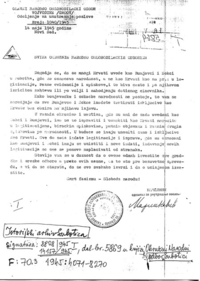
Around the time of World War I, was argued an idea that Bunjevci were not only a distinct group but also a fourth and smallest Yugoslav nation.[31] In October 1918, Bunjevci held a national convention in Subotica and decided to secede Banat, Bačka and Baranja from the Kingdom of Hungary and to join Kingdom of Serbia. This was confirmed at the Great National Assembly of Serbs, Bunjevci and other Slavs in Novi Sad, which proclaimed unification with the Kingdom of Serbia in November 1918. The subsequent creation of the Kingdom of the Serbs, Croats and Slovenes (renamed Yugoslavia in 1929) brought most of the Bačka Bunjevci in the same country with the Croats (with some remaining in Hungary).
Between the World Wars, the national dispute included pro-Bunjevci, pro-Croatian, and pro-Serbian position. As Bunjevci were mostly supporters of the Croatian Peasant Party, and the ethnic boundary between Serbs and Croats was established on confessional line, they naturally felt closer to Croats.[32] During the late World War II, Partisan General Božidar Maslarić spoke on the national councils in Sombor and Subotica on 6 November 1944 and General Ivan Rukavina on Christmas in Tavankut in the name of the Communist Party about the Croatdom of the Bunjevci. After 1945, in SFR Yugoslavia the census of 1948 did not officially recognize the Bunjevci (nor Šokci), and instead merged their data with the Croats, even if a person would self-declare as a Bunjevac or Šokac.[33] However, in local schools was used the Serbian version of the Serbo-Croatian language in Latin script, while during the 1990s even in Cyrillic script, policy interpreted as an attempt to assimilate them into the Serbian culture.[32]
Proponents of a distinct Bunjevac ethnicity regard this time as another dark period of encroachment on their identity and feel that this assimilation did not help in the preservation of their language. The censuses of 1953 and 1961 also listed all declared Bunjevci as Croats. The 1971 population census listed the Bunjevci separately under the municipal census in Subotica upon the personal request of the organization of Bunjevci in Subotica. It listed 14,892 Bunjevci or 10.15% of the population of Subotica. Despite this, the provincial and federal authorities listed the Bunjevci as Croats, together with the Šokci and considered them that way officially at all occasions. In 1981 the Bunjevci made a similar request – it showed 8,895 Bunjevci or 5.7% of the total population of Subotica. Many, on an example of Donji Tavankut, also declared as Yugoslavs.[34]
Contemporary period
Serbia
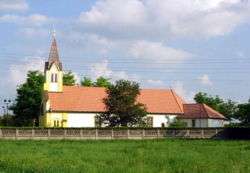
Following the breakup of Yugoslavia in the 1990s, Bunjevac nationality was officially recognized as a minority group in Serbia in 1990. They were granted the status of autochthonous people in 1996.[35] In 1991 census lived 74,808 Croats, and 21,434 Bunjevci in Vojvodina, while in the district of Subotica, there were approximately equal numbers of declared Croats and Bunjevci: 16,369 and 17,439.[34] In the administrative area of the city of Subotica region, there were 13,553 Bunjevci and 14,151 in 2011. The historically Bunjevac village of Donji Tavankut had 1,234 Croats, 787 Bunjevci, 190 Serbs and 137 declared as Yugoslavs. A 1996 survey by the local government in Subotica found that in the community, there are many people who declare as Croats and consider themselves Bunjevci, but also some people who declare as Bunjevci but consider themselves part of the wider Croatian nation. The same survey found that the delineation between the pro-Croat and pro-Bunjevac positions correlated with the delineation between the people who were more supportive towards the then ruling regime in Serbia that did not favor special rights for national minorities, and conversely those who were against the then government and more interested in minority rights and connections with what they saw as their second homeland.[36]
In early 2005, the Bunjevac issue was again popularized when the Vojvodina government decided to allow the official use of "bunjevački language with elements of national culture" in schools in the following school year – the Štokavian dialect with ikavian pronunciation. This was protested by the Croatian Bunjevac community as an attempt of the government to widen the rift between the two Bunjevac communities. They favour integration, regardless of whether some people declared themselves distinct, because minority rights (such as the right to use a minority language) are applied based on the number of members of the minority. As opposed to this, supporters of pro-Bunjevci option are accusing Croats for attempts to assimilate Bunjevci.[37] In 2011, Bunjevac politician Blaško Gabrić and Bunjevac National Council asked Serbian authorities to start juristic criminal responsibility procedure against those Croats who denying the existence of Bunjevci ethnicity, which is, according to them, violation of laws and constitution of the Republic of Serbia.[37]
Today, both major parts of the community (the pro-independent Bunjevac one and the pro-Croatian one) continue to consider themselves ethnologically as Bunjevci, although each subscribing to its interpretation of the term.
Hungary
In Hungary, Bunjevci are not officially recognized as a minority; the government simply consider them Croats. In April 2006 a Bunjevci group began collecting subscriptions to register Bunjevci as a distinct minority group. In Hungary, 1,000 valid subscriptions are needed to register an ethnic minority with historical presence. By the end of the given 60 days period, the initiative gained over 2,000 subscriptions of which cca. 1,700 were declared valid by national vote office and Budapest parliament gained a deadline of 9 January 2007 to solve the situation by approving or refusing the proposal. No other such initiative has reached that level ever since minority bill passed in 1992.[38] On 18 December the National Assembly of Hungary refused to accept the initiative (with 334 No and 18 Yes votes). The decision was based on the study of the Hungarian Academy of Science that denied the existence of an independent Bunjevac minority (they stated that Bunjevci are a Croatian subgroup). The opposition of Croatian minority leaders also played part in the outcome of the vote,[39] and the opinion of Hungarian Academy of Sciences.[40]
Demographics
Serbia

In Serbia, Bunjevci live in Autonomous Province of Vojvodina, mostly in the northern part of Bačka region. The community, however, has been divided around the issue of the ethnic affiliation: in the 2011 census, in terms of ethnicity, 16,706 inhabitants of Vojvodina self-declared as Bunjevci and 47,033 as Croats. Not all of the Croats in Vojvodina have Bunjevac roots; the other big group are Šokci.
The largest concentration of Bunjevci in Serbia (9,235) is in the ethnically mixed city of Subotica, which is their cultural and political center. Another significant urban center of Bunjevac people is the city of Sombor (1,629). Villages with a significant population of Bunjevci are all located in the administrative area of the city of Subotica:
Hungary
Towns and villages in Hungary with a significant population of Bunjevci (names of settlements in the Bunjevac dialect listed in brackets):
Villages which were partially populated by significant populations of Bunjevci in the past, but today have less than 70 Bunjevci villagers each:
Culture
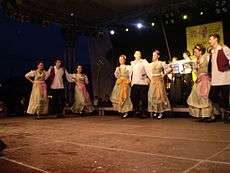
The cultural center of Danube Bunjevci from Bačka is the city of Subotica in Serbia, in Bács-Kiskun is Baja (those in Szeged became extinct as a distinct ethnic group due to assimilation),[9] while of littoral or coastal Bunjevci is the city of Senj. As the former live in a region inhabited by a population of the same nationality, they are far more assimilated, show less appreciation for traditional clothing and heritage due to external factors, but although mostly aware of their identity there's indifference for connection to other Bunjevci branches in Lika and Danube.[41] Traditionally, Bunjevci of Bačka are associated with land and farming. Large, usually isolated farms in Northern Bačka called salaši are a significant part of their identity. Most of their customs celebrate the land, harvest, horse-breeding, and their most important feasts (other than Christmas and weddings) are:
- Dužijanca – celebration of harvest end, and the most famous festival as well as a tourist attraction. It consists of several events held in Bunjevci-populated places (Bajmok, Donji Tavankut, Gornji Tavankut), with the central celebration held in Subotica. Dužijanca includes religious celebrations devoted to harvesting, street procession and performing of Bunjevci folklore and music.
- Krsno ime – a celebration of a patron saint of the family.
- Kraljice – ceremonial processions held on Pentecost.
- Divan – a meeting of young boys and girls for singing and dancing in a place far from their parents. The custom has been forbidden by church authorities already in the mid-19th century.
Bunjevačke novine ("Bunjevac newspaper") is the main newspaper in Bunjevac dialect, published in Subotica.[42][43]
Notable people
| Part of a series on |
| Croats |
|---|
 |
|
Subgroups |
- Gaja Alaga (1924–1988), theoretical physicist
- Ivan Antunović (1815–1888), writer and bishop
- Zvonko Bogdan, singer of traditional music
- Mara Đorđević-Malagurski (1894–1971), writer and ethnographer
- Antun Gustav Matoš (1873–1914), Croatian writer
- Ivan Gutman (1947–), chemist and mathematician
- Gyula J. Obádovics (b. 1927), Hungarian professor of mathematics
- Blaško Rajić (1878–1951), priest and writer
- Ivan Sarić (1876–1966), aviation pioneer and athlete
- Mirko Vidaković (1924–2002), botanist and member of the Croatian Academy of Sciences and Arts
See also
- Šokci
- Roman Catholicism in Serbia
References
Citations
- Černelić 2016, p. 11–12.
- Šarić, Marko (2009). Holjevac, Željko (ed.). "Predmoderne etnije u Lici i Krbavi prema popisu iz 1712./14" (PDF). Identitet Like: Korijeni I Razvitak (in Serbo-Croatian). Zagreb: Institut društvenih znanosti Ivo Pilar. 1: 338, 347–350, 357, 360, 369–372. ISBN 978-953-6666-65-2.
- "Bunjevci". Hrvatski jezični portal.
Bùnjevci... etn. Hrvati naseljeni u Bačkoj, koji su se u 17. st. doselili iz Kliškog i Krčkog sandžaka (kraj oko Zrmanje)...
- Petar Skok (1971). Etimologijski rječnik hrvatskoga ili srpskoga jezika I: A–J (in Serbo-Croatian). JAZU. pp. 237–238.
- Ladislav Heka (2010). "Uloga Hrvata u povijesti slobodnog i kraljevskog grada Szegedina". Annals of the Institute for Scientific and Art Research Work in Osijek (in Serbo-Croatian) (26): 57–73.
- Černelić 2016, p. 215–216.
- Bojan Mucko (2008). "About identity of coastal Bunjevci: Examples from Krmpote and Northern Velebit". Senjski Zbornik: Prilozi Za Geografiju, Etnologiju, Gospodarstvo, Povijest I Kulturu (in Serbo-Croatian). 35 (1): 213–239.
- Milana Černelić; Marijeta Rajković Iveta (2010). "Ogled o primorskim Bunjevcima: povijesna perspektiva i identifikacijski procesi". Studia ethnologica Croatica (in Serbo-Croatian). 22 (1): 283–316.
- László Heka (2009). Povijesna uloga i značenje Hrvata Dalmatina u životu Segedina / A Szegedi Dalmaták (Bunyevácok)története (in Hungarian and Croatian). Szeged: Bába. Retrieved 2 July 2018.
- Černelić 2016, p. 16.
- Černelić 2016, p. 13.
- Karl Kaser; Hannes Grandits; Siegfried Gruber (2003). Holjevac, Željko (ed.). Popis Like i Krbave 1712. godine : obitelj, zemljišni posjed i etničnost u jugozapadnoj Hrvatskoj (PDF) (in Serbo-Croatian). Zagreb: Srpsko kulturno društvo Prosvjeta. p. 20–21, 30, 264. ISBN 953-6627-52-3.
- Černelić 2016, p. 14.
- Černelić 2016, p. 14–15.
- Černelić 2016, p. 215.
- Pavle Rogić (1966). "Antroponimija i porijeklo stanovništva u naseljima srednjeg velebitskog Podgorja". Hrvatski dijalektološki zbornik (in Serbo-Croatian). Croatian Academy of Sciences and Arts (2): 319–321. Retrieved 24 June 2018.
Tu su se izmiješali s tamošnjim starosjediocima, koji su ih, po svoj prilici, i prozvali Bunjevcima, kao ljude koji žive i stanuju u bunjama, tj. u primitivnim kućama, najčešće okrugla, rjeđe četvrtasta oblika, zidanih u suho i različitog od tipa primorskih kuća.
- Mažuranić, Vladimir (1908–1922). Prinosi za hrvatski pravno-povijesni rječnik [Contributions to the Croatian legal-historical dictionary]. JAZU.
- Mažuranić, Vladimir (1908–1922). Prinosi za hrvatski pravno-povijesni rječnik [Contributions to the Croatian legal-historical dictionary]. JAZU. p. 109, 781.
- Todosijević 2002, p. 3.
- "Bunjevci". Croatian Encyclopedia. LZMK. Retrieved 23 June 2018.
- Černelić 2016, p. 207–218, 249.
- Milana Černelić (2003). "Investigation of Traditional Heritage, Identity and Ethno-Genesis of Coastal Bunjevci". Senjski zbornik : Prilozi za geografiju, etnologiju, gospodarstvo, povijest i kulturu (in Serbo-Croatian). 30 (1): 407–422.
- Černelić 2016, p. 215, 250–251, 255–256.
- Vitomir Belaj (2004). "Tradicijsko planinsko stočarstvo na Velebitu i bunjevačka etnogeneza" [Traditional Mountain Cattle Breeding on the Mountain of Velebit and Ethnogenesis of Bunjevci]. Studia ethnologica Croatica (in Serbo-Croatian). 16 (1): 5–31.
- Karl Kaser (2012). Household and Family in the Balkans: Two Decades of Historical Family. LIT Verlag Münster. p. 111–112.
- Todosijević 2002, p. 1.
- Milana Černelić (1995). "Attempts to Deny the Bunjevci of Bačka the Rights to Belong to the Croat Nation". Studia ethnologica Croatica (in Serbo-Croatian). 6 (1): 85–103.
- Damir Magaš; Josip Brtan (2015). Prostor i vrijeme knezova Posedarskih: Zemljopisna obilježja i povijesni razvoj Općine Posedarje (Posedarje, Slivnica, Vinjerac, Podgradina, Islam Latinski, Ždrilo i Grgurice) (in Croatian). Zadar: Sveučilište u Zadru, Centar za istraživanje krša i priobalja, Odjel za geografiju, Hrvatsko geografsko društvo Zadar. pp. 117–118. ISBN 978-953-331-059-6.
- Černelić 2016, p. 15.
- Todosijević 2002, p. 7.
- Todosijević 2002, p. 9.
- Todosijević 2002, p. 10.
- "Bunjevci ni zvanično neće morati da budu Hrvati?". Večernje Novosti. 3 February 2018.
- Todosijević 2002, p. 11.
- "Bunjevci – to be granted status of people". Politika. 1 October 1996. Retrieved 4 March 2011.
- Todosijević 2002, p. 11–12.
- "Archived copy". Archived from the original on 18 August 2011. Retrieved 25 May 2011.CS1 maint: archived copy as title (link)
- Nemzetiségi elismerést a bunyevácoknak – Index Fórum
- Iromány adatai
- "Hrvatski glasnik br.3" (PDF). Archived from the original (PDF) on 4 March 2009. Retrieved 9 July 2008. Odbijena narodna inicijativa... , 18 January 2007 (714KB)(in Croatian)
- Milana Černelić (2005). "Approaches to the Research of the Identity of the Ethnic Group of Bunjevci". Studia ethnologica Croatica (in Serbo-Croatian). 17 (1): 25–49.
- Bunjevačke novine
- "Bunjevačke novine".
Sources and further reading
- Beckett, Weaver Eric (2011). "Hungarian views of the Bunjevci in Habsburg times and the inter-war period". Balcanica. 42: 77–115.
- Černelić, Milana (2016). Bunjevci: Ishodišta, sudbine, identitet. FF Press. ISBN 978-953-175-376-0.
- Mandić, Mijo (2009). "Buni, bunievci, bunjevci". Bunjevačka matica. Cite journal requires
|journal=(help) - Šarić, Marko (2008). "Bunjevci u ranome novom vijeku. Postanak i razvoj jedne predmoderne etnije". Živjeti Na Krivom Putu. Zagreb: FF Press: 15–43.
- Sekulić, Ante (1989). Bački bunjevci i šokci. Školska knj.
- Skenderović, Robert (2012). "The formation of the political identity of the Bunjevci during the second half of the 19th century". Časopis Za Suvremenu Povijest. 44 (1): 137–160.
- Todosijević, Bojan (2002). "Why Bunjevci did not become a nation: A case study". East Central Europe. 29 (1–2): 59–72. doi:10.1163/187633002X00046.
- Vukić, Aleksandar; Bara, Mario (2013). "The Importance of Observation, Classification and Description in the Construction of the Ethnic Identity of Bunjevci from Bačka (1851–1910)". Dve Domovini. 37: 69–81.
External links
| Wikisource has original text related to this article: |
| Wikimedia Commons has media related to Bunjevci. |
- Bunjevci.com
- Bunjevci HKPD Matija Gubec Tavankut
- Hrvatska revija br. 3/2005. Proslava 250. obljetnice doseljavanja veće skupine Bunjevaca (1686.-1936.) – Bunjevci u jugoslavenskoj državi
- HIC Međunarodni znanstveni skup "Jugoistočna Europa 1918.-1995."
- The Croatian Bunjevci
- Bunjevci in Senj (Croatia)
- Ivan Ivanić: O Bunjevcima (Subotica, 1894)
- Representations of Bunjevci in Hungary

